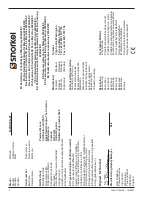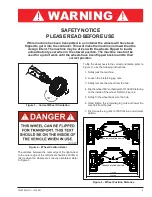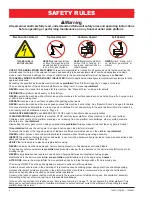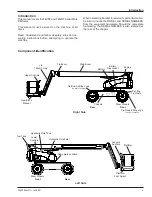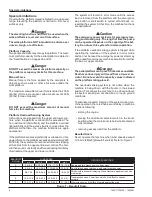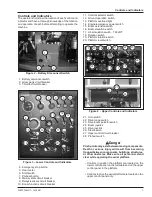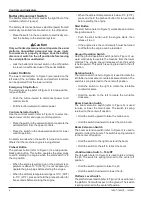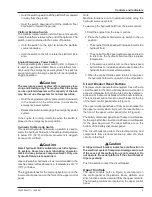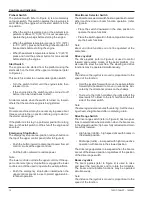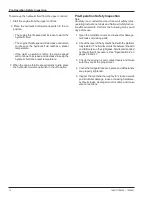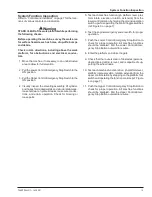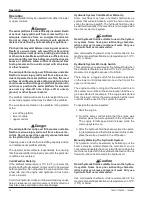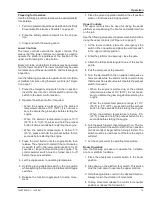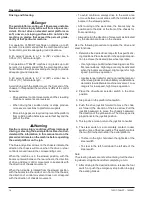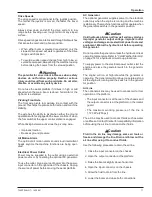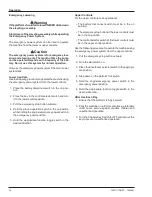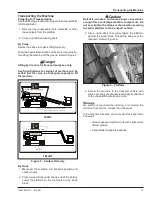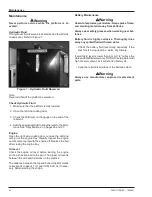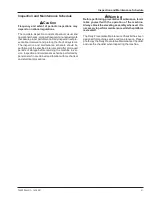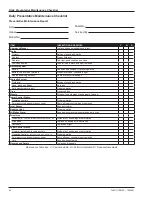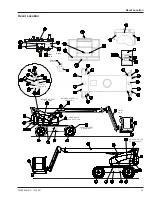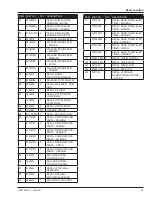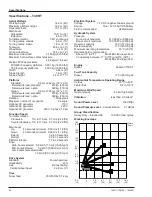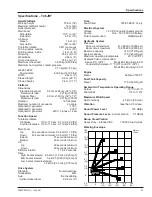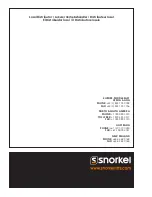
Operation
14
T40RT/T46JRT – 1430001
Operation
The aerial platform may be operated from either the lower
or upper controls.
Danger
The aerial platform is not electrically insulated. Death
or serious injury will result from contact with, or in-
adequate clearance from, an energized conductor.
Do not go closer than the minimum safe approach
distance as defined by national safety regulations.
Pinch points may exist between moving components.
Death or serious injury will result from becoming
trapped between components, buildings, structures,
or other obstacles. Make sure there is sufficient clear-
ance around the machine before moving the chassis,
booms, or platform. Allow sufficient room and time
to stop movement to avoid contact with structures
or other hazards.
The aerial platform can tip over if it becomes unstable.
Death or serious injury will result from a tip-over ac-
cident. Operate the aerial platform on a firm, flat, level
surface. Avoid travel speeds and/or rough terrain that
could cause sudden changes in platform position. Do
not drive or position the aerial platform for elevated
use near any drop-off, hole, slope, soft or uneven
ground, or other tip-over hazard.
The platform rated work load is the total weight of the per-
sonnel and equipment that may be lifted in the platform.
The work loads are stated on the platform rating placard
at the:
rear of the platform
lower controls
upper controls
Danger
The aerial platform can tip over if it becomes unstable.
Death or serious injury will result from a tip-over ac-
cident. Do not exceed the capacity values indicated
on the platform rating placard.
Capacity values indicate the rated lifting capacity and do
not indicate aerial platform stability.
The operator bears ultimate responsibility for ensuring
that the aerial platform is properly set up for the particular
conditions encountered.
Cold Weather Start-Up
If the ambient temperature is 0°C (32°F) or below, the
engine and hydraulic system oil may need to be warmed
before operation. Do not operate the engine at more than
a fast idle until the engine and hydraulic oil has had a
chance to warm.
Cold, thick hydraulic oil does not flow well and may cause
delay in response to control movement. Cold hydraulic oil
may also cause cavitation and pump damage.
•
•
•
Hydraulic System Cold Weather Warm-Up
Some machines may have a hydraulic fluid warm-up
system that will automatically warm the fluid upon acti-
vating the warm-up switch. The hydraulic fluid may also
be warmed manually if the machine is not equipped with
the optional warm-up system.
Caution
Not all hydraulic fluid is suitable to use in the hydrau-
lic system. Some have poor lubricating character-
istics and may increase component wear. Only use
hydraulic fluid as recommended.
Use cold weather hydraulic oil as recommended in the
machine General Specifications in temperatures of -12°C
(10°F) or below.
Hydraulic System Warm-Up Switch
This system may be used to warm the hydraulic fluid when
the ambient temperature is below 0°C (32°F) and boom
movement is sluggish because of cold fluid.
There may be a toggle switch for the warm-up system
on the lower control panel and/or one on the front of the
upper control panel.
The engine must be running and the switch used to turn
the system on must be at the same location that the en-
gine was started. For example, if the engine was started
from the lower controls, the warm-up switch at the lower
controls must be used for the system to operate.
To operate the warm-up system:
1. Start the engine.
2. From the same control station that the engine was
started, place the warm-up switch in the on position.
The engine throttle speed will increase while the
warm-up system is on.
3. After the hydraulic fluid has been warmed to operat-
ing temperature and the throttle speed returns to idle,
place the warm-up switch in the off position.
Manually Warming The Hydraulic System
The hydraulic oil may be warmed by bottoming out the
boom extension cylinder. Raise the main boom so it is
horizontal and operate the boom retract function while the
machine is stowed. With the cylinder bottomed out the oil
flow will produce heat to warm the hydraulic oil.
Caution
Not all hydraulic fluid is suitable to use in the hydrau-
lic system. Some have poor lubricating character-
istics and may increase component wear. Only use
hydraulic fluid as recommended.
Use cold weather hydraulic oil as recommended in the
machine General Specifications in temperatures of -12°C
(10°F) or below.
Summary of Contents for 16GTRD
Page 2: ......



